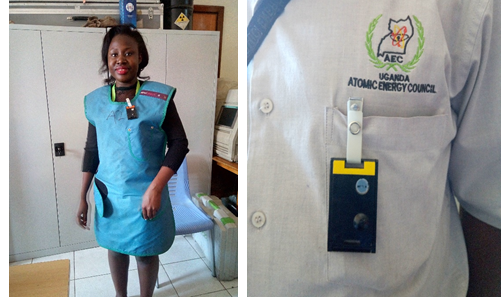Uganda’s AEC offers dosimetry services to the general public. Personal Dosimetry refers to assessment of doses to individuals using personal dosimeters…
Personal Dosimetry
Personal Dosimetry refers to assessment of doses to individuals using personal dosimeters (thermolumniscent dosimeters).
It is important to record and manage personal doses associated with work with ionizing radiation in order not to exceed the regulatory limits. However, it should be noted that regulatory limits do not indicate safe and unsafe situations.
Quantities Used
Dosimeters for external radiation cannot directly measure the protection quantities: effective dose (E) and tissue equivalent doses (HT). Instead measurements are made of the personal dose equivalent operational quantities, Hp(d) such as Hp(10), Hp(0.07) and Hp(3) at standard dosimeter wear positions on the body and use these as approximations for E and HT. These are termed the ‘operational dose quantity approximations’.
Classification of Personal Dosimeters
Personal dosimeters are classified into two categories; passive whole-body personal dosimeters and active personal dosimeters (APD).
Passive Whole-body Personal Dosimeters
These are worn for some period and store accumulated doses which are read after the wearing period. Examples of passive whole-body dosimeters are; thermolumniscent (TL) dosimeters, Optically Stimulated Luminescence (OSL) dosimeters and Radio Photo Luminescence (RPL) dosimeters.
Passive Whole-body Personal Dosimeters are utilized at most sites. The issue/wear period of personal passive dosimeters will be dependent on the exposure situation and should be determined by the risk assessment and dosimetry selection process. In general terms, a short issue period would be considered where doses could be significant.
For classified persons the wear period is normally one month. Where doses are generally low and where the risk of a high exposure is low, then a longer issue period, typically three months, may be appropriate.
Advantages of passive whole-body personal dosimeters
(i) They are portable
(ii) They are easy to use
(iii) They are cheap
Disadvantages of passive whole-body personal dosimeters
(i) They do not give a direct read out to the wearer.
(ii) They do not provide any feedback to the wearer as to how a certain activity is impacting their received dose.
Active Personal Dosimeters (APD)
APDs dosimeters:
(i) Give instant indication of both accumulated dose and dose rate
(ii) Give preset visual and audible alarms
(iii) Give integrating dosimeter, linked to site control system
(iv) Are used as supplementary dosimeters to a passive dosimeter
Examples of APDs are; Electronic personal dosimeter (EPD) and MOSFET dosimeter.
Advantages of Active Personal Dosimeters
(i) Provide near immediate assessment and evaluation (real time dose measurement).
(ii) Have energy and directional response characteristics and, in most cases are, as good as passive dosimeters, able to measure with acceptable accuracy for continuous fields, however care must be applied in presence of pulsed fields.
(iii) Provides real time short term and long term dose control and constraints against individual tasks and projects.
(iv) Have ability to link real time dose information between various sites.
(v) Supports access control systems.
(vi) They also operate over a wide energy range from 15 keV through to 10 MeV, capturing radiation of all energies.
Disadvantages of Active Personal Dosimeters (APDs)
(i) They are expensive.
(ii) They are a little bulky.





